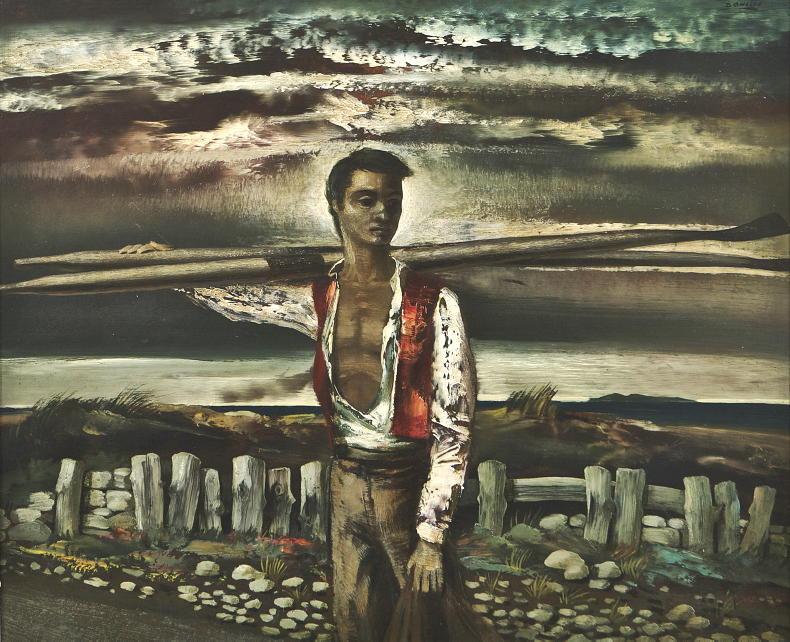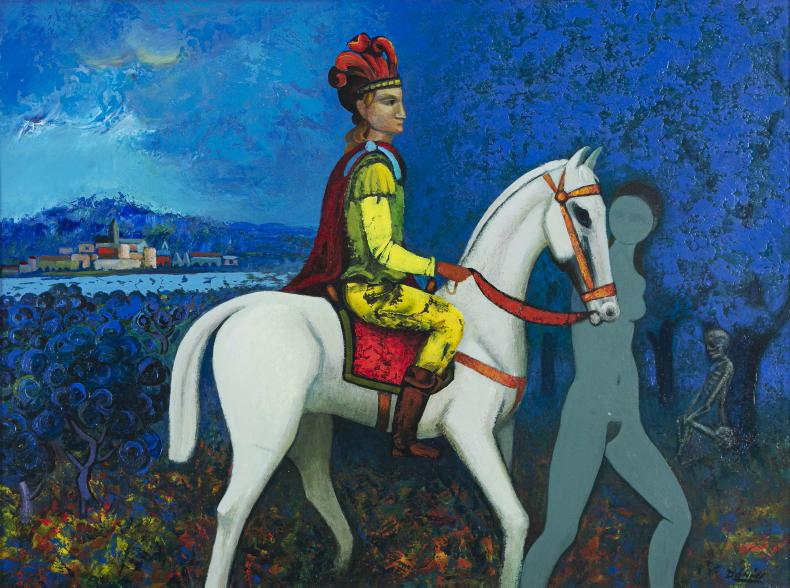I will put my hands up and say that the name Daniel O’Neill, an Irish-born artist, was not well-known to me. That was until two weeks ago when I came into possession of a beautifully produced, coffee table book written by Karen Reihill.
This monograph on the life of O’Neill was actually produced to coincide with the centenary of the artist’s birth, and was first available late last year. Born in Belfast on 21 January, 1920, to a working-class Catholic family, Daniel O’Neill enjoyed a great deal of success at a time when Ireland was very much in a state of change, both in the north of the country and down south.
Reihill’s work not only brings to our attention O’Neill’s work as an artist, including many pieces seen for the first time, but it sheds a light on the artist’s complex personal life, and that of his relationship with his dealer, Victor Waddington, whose clients included Jack B Yeats. Intertwined with the personal narrative, Reihill also tells the story of Ireland at the time, and the many happenings that were playing out across the island.

Paintings by Daniel O'Neill.
In 2020, a year of major disruption for all art pursuits, one of the events to suffer, not once but twice, was a retrospective Daniel O’Neill Romanticism & Friendships. Curated by Karen Reihill, it was originally scheduled to open last May at The Farmleigh Gallery, but due to COVID-19 restrictions had to be rescheduled to open in late November when it was again cancelled.
However, Reihill was determined to mark O’Neill’s centenary year and she pushed ahead with the independent publication of her more than 190-page monograph. In a way, this was the completion of a triptych of sorts for the author. In the 1940s, the north of Ireland painters Gerard Dillon, George Campbell and Daniel O’Neill were known as “The Belfast Boys”. Reihill has previously published works on Dillon (2013) and Campbell (2015).
The quality of the more than 370 illustrations of his work and of the period is to be commended
She told me that her latest work was the most difficult of the three, saying that he was “by far the most challenging figure in the group. I completed my draft and tore it up and started again”. The book, which is named after the yet-to-be-seen retrospective, is the result of many years of research and contains a great deal of never before published information on the artist, his life and the art scene in Dublin and Belfast from the 1940s until the early 1970s.
The quality of the more than 370 illustrations of his work and of the period is to be commended. An additional selling point is that the book contains not just the best of O’Neill’s own work, but it is augmented with many works by the other Belfast boys, Dillon and Campbell.
Other artists whose work complements those three, and are encompassed, include Markey Robinson (a personal favourite of mine), Colin Middleton, Nano Reid, Arthur Campbell (brother of George), James MacIntyre and Nevill Johnson.
O’Neill’s life was a rocky one and ended with his untimely death in 1974. Largely forgotten since, it is a credit to Reihill that she has put his name back in the public arena, and hopefully the twice-postponed retrospective will see the light of day. O’Neill’s work deserves to be seen, and Reihill is to be commended for her efforts to bring them together.
Available to order from your local bookshop or online at www.frederickgallerybookshop.com, this independently published Irish book will brighten up even the gloomiest of January days, and comes with a five-star recommendation.
Daniel O’Neill Romanticism & Friendships is priced at €25.
I will put my hands up and say that the name Daniel O’Neill, an Irish-born artist, was not well-known to me. That was until two weeks ago when I came into possession of a beautifully produced, coffee table book written by Karen Reihill.
This monograph on the life of O’Neill was actually produced to coincide with the centenary of the artist’s birth, and was first available late last year. Born in Belfast on 21 January, 1920, to a working-class Catholic family, Daniel O’Neill enjoyed a great deal of success at a time when Ireland was very much in a state of change, both in the north of the country and down south.
Reihill’s work not only brings to our attention O’Neill’s work as an artist, including many pieces seen for the first time, but it sheds a light on the artist’s complex personal life, and that of his relationship with his dealer, Victor Waddington, whose clients included Jack B Yeats. Intertwined with the personal narrative, Reihill also tells the story of Ireland at the time, and the many happenings that were playing out across the island.

Paintings by Daniel O'Neill.
In 2020, a year of major disruption for all art pursuits, one of the events to suffer, not once but twice, was a retrospective Daniel O’Neill Romanticism & Friendships. Curated by Karen Reihill, it was originally scheduled to open last May at The Farmleigh Gallery, but due to COVID-19 restrictions had to be rescheduled to open in late November when it was again cancelled.
However, Reihill was determined to mark O’Neill’s centenary year and she pushed ahead with the independent publication of her more than 190-page monograph. In a way, this was the completion of a triptych of sorts for the author. In the 1940s, the north of Ireland painters Gerard Dillon, George Campbell and Daniel O’Neill were known as “The Belfast Boys”. Reihill has previously published works on Dillon (2013) and Campbell (2015).
The quality of the more than 370 illustrations of his work and of the period is to be commended
She told me that her latest work was the most difficult of the three, saying that he was “by far the most challenging figure in the group. I completed my draft and tore it up and started again”. The book, which is named after the yet-to-be-seen retrospective, is the result of many years of research and contains a great deal of never before published information on the artist, his life and the art scene in Dublin and Belfast from the 1940s until the early 1970s.
The quality of the more than 370 illustrations of his work and of the period is to be commended. An additional selling point is that the book contains not just the best of O’Neill’s own work, but it is augmented with many works by the other Belfast boys, Dillon and Campbell.
Other artists whose work complements those three, and are encompassed, include Markey Robinson (a personal favourite of mine), Colin Middleton, Nano Reid, Arthur Campbell (brother of George), James MacIntyre and Nevill Johnson.
O’Neill’s life was a rocky one and ended with his untimely death in 1974. Largely forgotten since, it is a credit to Reihill that she has put his name back in the public arena, and hopefully the twice-postponed retrospective will see the light of day. O’Neill’s work deserves to be seen, and Reihill is to be commended for her efforts to bring them together.
Available to order from your local bookshop or online at www.frederickgallerybookshop.com, this independently published Irish book will brighten up even the gloomiest of January days, and comes with a five-star recommendation.
Daniel O’Neill Romanticism & Friendships is priced at €25.







 This is a subscriber-only article
This is a subscriber-only article









SHARING OPTIONS: